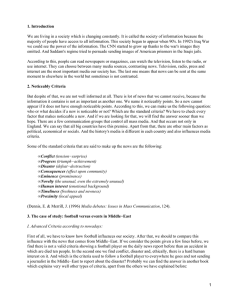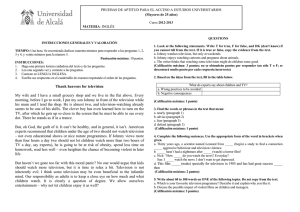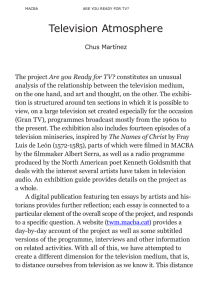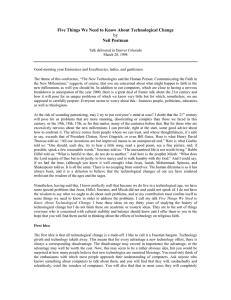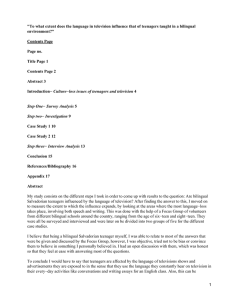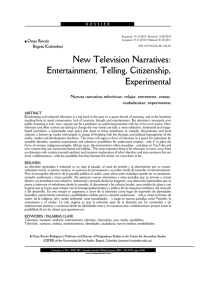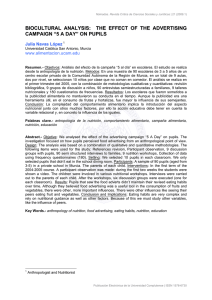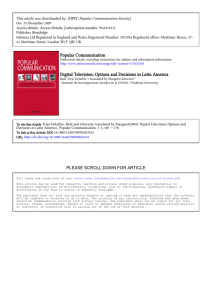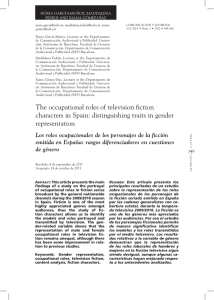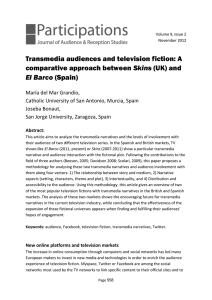Absolute Emptiness. The Null-Medium, or Why all
Anuncio
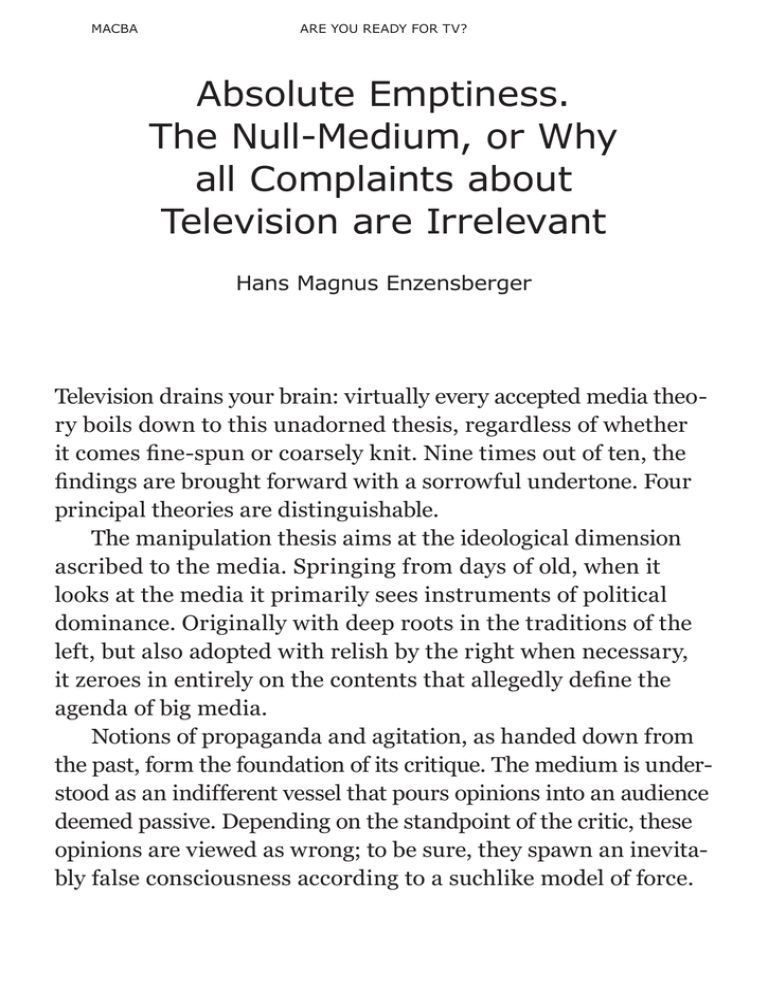
MACBA ARE YOU READY FOR TV? Absolute Emptiness. The Null-Medium, or Why all Complaints about Television are Irrelevant Hans Magnus Enzensberger Television drains your brain: virtually every accepted media theory boils down to this unadorned thesis, regardless of whether it comes fine-spun or coarsely knit. Nine times out of ten, the findings are brought forward with a sorrowful undertone. Four principal theories are distinguishable. The manipulation thesis aims at the ideological dimension ascribed to the media. Springing from days of old, when it looks at the media it primarily sees instruments of political dominance. Originally with deep roots in the traditions of the left, but also adopted with relish by the right when necessary, it zeroes in entirely on the contents that allegedly define the agenda of big media. Notions of propaganda and agitation, as handed down from the past, form the foundation of its critique. The medium is understood as an indifferent vessel that pours opinions into an audience deemed passive. Depending on the standpoint of the critic, these opinions are viewed as wrong; to be sure, they spawn an inevitably false consciousness according to a suchlike model of force. 10 ABSOLUTE EMPTINESS… Sophisticated methods employed by the critique of ideology expand this ‘razzle-dazzle relation’ by equipping the enemy with ever more subtle and insidious intentions. Enigmatic temptation takes the place of direct agitation; the unsuspecting consumer is coaxed by the mastermind before he knows what hit him. In contrast, the mimicry thesis argues moralistically. In its eyes media consumption carries primarily ethical dangers. He who exposes himself to it becomes accustomed to libertinage, irresponsibility, crime and violence. The subjective results are stupefied, callous and pigheaded individuals; the objective results, the loss of social virtues and the decay of morals across the board. This form of media critique feeds, as is visible at first glance, on bourgeois resources. Its recurrent motifs can already be documented during the eighteenth century, in the futile warnings, sounded by early cultural criticism, of the dangers posed by reading novels. A more recent thesis is one of simulation, which is inspirited with a cognitive-theoretical suspicion. It is more modern insofar as it shows an interest in the technical evolvement of the media, thus also taking the existence of television seriously, which is more than one can say for its predecessors. According to the simulation thesis, the viewer’s faculty for distinguishing between reality and fiction is disabled by the medium. The primary reality is therefore blurred or replaced by a second, delusional one. An advanced version of this thesis, which occasionally even emerges as affirmative, reverses this relation and claims that the differentiation between reality and simulation has, under existing societal circumstances, become meaningless. All aforementioned theses converge in the fourth, the braindrain thesis, which condenses into an anthropological proposition. 11 ABSOLUTE EMPTINESS… The media, if one follows this proposition, attacks not only the capacity for critique and differentiation, not only the moral and political substance of its users, but also their capacity for perception; yes, even their mental and spiritual identity. Hence the media produces, if one allows them, a new human being whom one could imagine, at whim, as a zombie or mutant. All of these theories are merely skin and bones. Evidence is unnecessary as far as their creators are concerned. Not a moment’s sleep is lost over criteria as minimal as plausibility. Hence nobody, to name just one example, has succeeded in exhibiting, outside of the psychiatric clinic, just one ‘television subscriber’ who has been disabled in his capacity to differentiate between a marital quarrel in the current series, on the one side, and his breakfast table on the other. This seems not to bother any of the advocates of the simulation theory. Just as curious, but perhaps more momentous, is another common trait among the theories in question. In them the media user appears, fundamentally, as a defenceless victim, and the programmer, on the other hand, as a cunning perpetrator. The opposition is held on to with sincere sternness and formidable thoroughness: manipulators and manipulated, doer and imitator, simulator and simulated, brain-drainer and brain-drained all stand face to face in beautiful symmetry. It is imperative here that the question be left open: on which side could the respective theorist himself be located? If he makes absolutely no use of the media, then he has no idea what he is talking about. Alternatively, he exposes himself to it, then the question arises, by what miracle did he manage to escape its force? For, as antithesis to all others, morally he remains fully intact; he can sovereignly differentiate between smoke and mirrors, on the one hand, and 12 ABSOLUTE EMPTINESS… reality on the other. He enjoys complete immunity to the idiocy that he despairingly detects in all of them. Or might his theories – a fatal way out of the dilemma – be, in their own right, symptoms of a universal brain-draining? Be that as it may, no one can say that they were ineffectual. Admittedly, their influence on what gets broadcast is held in check, which, depending on one’s mood, can be deemed grim or thankfully made note of, though hardly controverted; whereas the makers of so-called media policy have decided to lend an ear. And this comes as no surprise, because every career politician possesses a set of basic psychic tools of the trade; and his conviction that he is dealing, ‘outside in the land’, with millions of idiots is part and parcel to those tools. The converse impression is consolidated when one follows how the veterans of the field wrestle with each other and with media functionaries for every minute when it comes to their limousines, their historic appearance before honorary company, their coiffure behind the flower vase and, above all, the showing off of their organ of speech. What a stirring zealousness in the racking up of broadcast minutes, camera angles, degrees of devotion on the part of the reporter, the sound level of the booming cheers! They have really taken a shine to the good old manipulation thesis. That explains the tenacious discord among the ‘boards’, the never-slackening patronage of the ministries, and the burning desire to secure control over the entire operation once and for all. The industry shares neither this passionate desire nor any of those arid theories. Its deliberations are those of ascetic sobriety. On the one hand they revolve around frequencies, channels, codes, cables, signal lobes, parabolic antennas; on the other, 13 ABSOLUTE EMPTINESS… around investments, holdings, distribution coefficients, costs, estimates, advertisement revenue. From this perspective, it appears that the truly new feature of the new media is the fact that none of its programmers has ever wasted a single moment’s thought on any sort of content. Each economic, technical, legal and administrative aspect of its procedure gets analysed exhaustively and is bitterly competitive. Only one factor fails to play a role in the thoughts and wishes of the industry: the programme. It is debatable who pays and who cashes in, when, where, how, from whom, but never ever what gets broadcast. Such a mindset would never have been thinkable with any earlier medium. It may seem peculiar, even foolhardy, the millions in expenditures dedicated to shooting satellites into outer space and blanketing all of Middle Europe with a cable network; an unprecedented proliferation of ‘means of communication’ is taking place, without so much as an inkling as to what should actually be conveyed. The solution to the riddle is, however, obvious. The industry itself is in accord with the crucial societal figure inside of their game: the ‘television subscriber’. He, without any degree of willlessness, energetically pilots a condition that one could define as programme-lessness. In order to come closer to this goal, he virtuosically utilises all available buttons on his remote control. There is no medicine in existence against this cosy alliance between customer and provider. The embittered minority of critics has difficulty explaining such an immense accord because it contradicts their self-image. How would it be if the majority had their reasons, reasons that might not be so readily traceable to the stupidity that is ascribed 14 ABSOLUTE EMPTINESS… them. How would it be if programmes indeed were dispensable and if the concept of the medium itself proved inept, a mere mystification? Perhaps it is well worth pursuing such hunches for a moment. The concept of the medium is old; what is meant here, for starters, is simply something medial, mediating; a medium in the sense of an instrument; in Greek grammar, a distinct kind of utterance that lends itself to emphasising ‘the interest of an active subject, or his being impacted through an action’; additionally, ‘in the spiritistic world view, someone who mediates communication with the spirit world’ (!); finally, in a physical sense, a carrier, such as air, in which waves of light and sound can travel; accordingly applied to societal communication, that communication’s technical medium, the letterpress for example. The concept of the programme also orients itself toward the written word. Indeed, this word originally indicated nothing other than a stipulation, that which is de rigueur, prewritten; ‘actual public written proclamation, public notice; now (1985) especially a letter of announcement or invitation issued by universities and other institutions of higher education. In public life, it means the agenda of a party, of a periodical, of an association formed for a particular purpose, also of a government, if the guidelines of the intended actions are announced in advance in more or less binding form.’ What the leading television programmers announce in advance, however, sounds like this: ‘Hoedown. Mini-ZIB. Hei Elei, Kuck Elei. You Again (8). Evening Dreams of the Moorlands. Almerish Singalong. World Cup Men’s Super-G. Helmi. X-Large. Golden Number One. Bonbons at Bedtime. Until the Trap is Sprung. Simply Animals. Let’s Make a Bet. Long Live Love. Mimi Never Says Beddy-Bye Without Her Murder Mystery. Just 15 ABSOLUTE EMPTINESS… Another Pretty Face. Tintifax and Max. I Want You to Love Me. Whateverrrrrr. Hulk (31). Musy and Metty. Today With Us. Hard as in Diamond. Am, Dam, Des. Barapapa. Texas Jack (12). Watch and Win. Super Flip. She – He – It. Love International. Hard with Heart. 1-2-X. Bigger Bids.’ * No further comments are necessary, in all likelihood, to show that these kinds of phenomena are no longer to be grasped by anachronistic terms like ‘medium’ or ‘programme’. The new in new media lies in the fact that they have ceased to be reliant on the programme. They can only measure up to their true purpose by approaching the status of the null-medium. Even the old media, as some retrospection shows, were no strangers to this tendency. The letterpress too didn’t spare any attempts at shedding ever-increasingly burdensome contents. The first pioneering achievements on this hard road came to fruition in the trashy novel. Other milestones have been set by the popular press, supermarket checkout literature and magazines. A triumphant record, which to this day has remained unbroken within the printing industry, is held, with the near transcendence of illiteracy’s wildest dreams, by Germany’s Bild-Zeitung. For all that, the most significant advances have been brought about by electronic media. As it turned out, insurmountable obstacles stood in the way of attempts at creating a printed null-medium. Those who wish to free the written word from * In the original German text the examples are the following: ’Budenzauber. MiniZiB. Ei elei, Kuck elei. Du schon wieder. Wenn abends die Heide träumt. Almerisch g’sunga und g’schpuit. Weltcup-Super G der Herren. Helmi. X-Large. Die Goldene Eins. Betthupferl. Bis die Falle zuschnappt. Einfach tierisch. Wetten, daß ...? Es lebe die Liebe. Ohne Krimi geht die Mimi nie ins Bett. Just another pretty face. Tintifax und Max. Ich will, daß du mich liebst. Also ääährlich. Hulk Musi mit Metty. Heute mit uns. Hart wie Diamant. Am, dam, des. Barapapa. Texas Jack, Schau hin und gewinn. Superflip. Sie - er - es. Liebe international. Hart aber herzlich. 1-2-X. Wer bietet mehr?’ 16 ABSOLUTE EMPTINESS… any and all meaning must go to extremes. The heroic proposals of the avant-garde (Dada, Lettrism, visual poetry) fell on dead ears within the industry. This is due, presumably, to the self-contradictory nature of a null-reading. The reader, every reader, has the fatal inclination for producing coherency, picking through even the most murky of alphabet soups in search of some semblance of sense. From a younger medium, such as radio, one could allowably expect even less, which means, in this context, more. At any rate, the emancipation from the written word established new perspectives. In practice it was shown, nonetheless, that radio broadcasts quite often involved the reciting of texts. Yet even there, where free speech was breaking ground in addresses and discussions, and, yes, even in sheer drivel, time and again the words activated something akin to meaning. Producing absolute nonsense-sentences that go on and on, that are resistant to injection with any howsoever-natured meaning, is widely recognised as being really hard, requiring practice and concentration. It is language itself that here produces something like a minimal programme. In order to get rid of this interference factor, the up-and-comers, at work in broadcasting for quite some time now, have systematically reduced word-related broadcasts. A certain blather-remainder is, however, left over; at least the appellations of idols and other brand-name items have to be exclaimed, for economic reasons, at regular intervals. Only the visual technologies, with television leading the way, are in any position to throw the ballast of language overboard and to take everything that was once called programme, meaning, ‘content’, and liquidate it. The evidence of the unfathomable possibilities of the null-medium is adduced by a simple experiment. 17 ABSOLUTE EMPTINESS… Put a six-month-old child in front of a video player. The infant is, for neurophysiological reasons, incapable of resolving and decoding the images, with the result that the question of whether they ‘mean’ anything cannot be asked in the first place. Nevertheless, the colourful, flickering, luminous patches unfailingly and unceasingly elicit, with no regard whatsoever to what appears on the screen, an intimate, or as one may wish to say, a voluptuous interest. The perceptual apparatus of the child is wonderfully occupied. The effect is hypnotic. It is impossible to say what goes on inside; or perhaps not, because the television, reflected in the infant’s eyes, lends those eyes an enraptured, absent-minded expression, to the extent that we are tempted to eulogise it happily. It will cost the friend of humanity little effort to condemn such an experimental procedure as a barbaric outrage. Before he submits to this temptation, he should bear in mind not only that this experiment is an instalment in daily routines a million times over; he would be better off asking himself to what extent his condemnation simultaneously implicates a culture that he perhaps treasures. For, without the pioneering achievements of modern art, the null-medium would be unimaginable. It is no accident that the coloured patches and configurations that our six-month-old test subject delights in are reminiscent of abstract painting. From Kandinsky to Action Painting, from Constructivism to the degradations of Op art and computer graphics, artists have done what they could to cleanse their works of ‘meaning’. Insofar as they succeeded in this minimalisation, they can by all means be regarded as trailblazers of the null-medium. This role becomes immediately comprehensible in video art, where, in more advanced productions, it is practically impossible to discern anything. 18 ABSOLUTE EMPTINESS… The originators and apologists of these arts are, of course, far from seeing themselves as the ones who lay the groundwork for the industry. In order to assert their status and presumably also their prices, they have developed their own ‘philosophy’, which is backed up more by shamanistic conspiracies than by arguments, and which they themselves presumably believe in. This delayed avant-garde wrongly imagines itself as an obstinate minority, disavowing that they, in the shape of the null-medium, have long ago conquered a mass audience. Admittedly, any movement towards absoluteness, towards perfection, is always a tedious, drawn-out process. That goes for television too. As an added impediment, the null-medium has to stand up to small yet influential minorities who are anxious to defend either historical leftovers or happy hopes for the future. On the one side, those with partisan interests, as well as media functionaries, hold on tenaciously to the belief that television can be roped into stabilising their power positions; on the other side, there is no shortage of pedagogues and critical theorists who can still sniff out productive forces in electronic media, the unleashing of which is valid only in order to set unforeseen learning processes in motion (a cheery message, composed of various pickings collected from old sets of media construction sets). In the course of time, a most peculiar coalition of adversarial brothers has formed around such ideas, and they have only one thing in common: one could call it the programme-illusion. In the Federal Republic of Germany this illusion even has legal force; it is anchored in treaties, agreements, broadcasting laws, statutes and guidelines and is, to all appearances absurd, caressed by all the people in charge. 19 ABSOLUTE EMPTINESS… Television programmes, as one here reads, ‘must be conveyed with a democratic spirit and a fidelity to the Basic Law for the Federal Republic of Germany… with an awareness of cultural responsibility and a will to objectivity. They should work for freedom, justice and truth’, ‘enjoin to freedom and to social justice’, ‘conduce both the reunification of Germany in peace and freedom, and communication and understanding among the people.’ It would make anyone shake their head in disbelief. The producers of shows and shockers, clips and commercials, should deliver not only ‘education, information and entertainment’, but also ‘humaneness’ and ‘objectivity’, ‘diversity of information’, ‘comprehensive and unbiased news coverage’ and of course, time and again, a wide ‘range of culture’. These phantasmagoric decrees issued by legislators are associated with the history of the founding of the broadcasting institutions. They were born at a time devoid of the faculty for anticipating what a fully developed null-medium is capable of. The ‘programme designers’, who adhere with as much powerlessness as stubbornness to the ‘binding mandate’ that they inherited from their fathers, cast us a melancholic glance. The permanent post is their doomed position from which they struggle for a television as pedagogical province, as moralistic establishment. The programme-illusion has not only juridical and institutional bases to thank; it emanates directly from the phylogenesis of the media. Throughout its evolution one can apply the theorem that every new medium initially orients itself by an older one, before it discovers its own possibilities and to some extent comes into its own. This heteronomy is also observable in television. Such being the case, the idea that it was designed to transport forms and 20 ABSOLUTE EMPTINESS… contents, ergo ‘programmes’, as yielded by earlier media, is difficult to exterminate. Technically this is by no means out of the question. Surely it is no impossible task to excavate a pit with a teaspoon or to transmit the bible by telex; only the teaspoon or the telex was not designed for such undertakings. The evolutionary eggshells that still stick to television are especially conspicuous on particular species that stand their ground in its broadcasting schedule like fossils. Hence the null-medium is haunted by alienated forms like the sermon, the opera, the chamber concert, the comedy of manners and the editorial, all of which have no business being there. There is also the conservation of types of radio, like the news bulletin, the discussion and the radio play, where the presence of the camera appears to be a superfluous luxury. Many a television veteran who has not recognised the sign of the times suffers also from the notion that their subject matter might run out. The idée fixe that something rather than nothing should be broadcast misleads them into cannibalising the old media. This leads above all to the cannibalistic salvaging of a medium that one likes to regard as a relative of television, namely the film. Naturally, it soon turned out that a mix-up was at hand. The aesthetic fascination of cinema is not repeatable on a television screen; it is destroyed by the laughable dimensions, the interruption by advertisements and the indifferent, ceaseless dubbing. The secret weapon of the viewer, the dreaded action of flipping, takes care of the rest. Yes, what about the viewer? He knows exactly what he is up to. He is invulnerable to every programme-illusion. Faced with his praxis, the guidelines of legislators go up in smoke. Far from giving himself over to manipulation (upbringing, 21 ABSOLUTE EMPTINESS… getting informed, education, enlightenment, instruction), he manipulates the medium in order to achieve his wishes. He who does not submit to his wishes will be punished with a withdrawal of affection at the push of a button; he who fulfils them will be rewarded with magnificent ratings. The viewer makes no bones about having in front of him not a means of communication, but a means of denial of communication, and he is not to be shaken in this belief. In his eyes, precisely the thing that he is accused of is what constitutes the charm of the null-medium. This also explains a feature of television that would be puzzling according to every other premise: its transcultural reach. The very same series, the very same video clip, the very same show unfurls, independent of any and all societal conditions, the same power of attraction in Lüdenscheid, Hong Kong and Mogadishu. No content can be as independent of every context, as irresistible, as universal. The null position represents not the weakness of television, but rather its strength. It constitutes its utility value. We turn the device on in order to turn off. (The things that politicians regard as politics are, for this reason, absolutely fit for television. While the pathetic minister fancies he has influence on the opinions and actions of the viewer, he only satisfies, with the viscous emptiness of his comments, the viewer’s need to be spared from meaning.) On the other hand, something like interference or break-up occurs the moment the broadcast flow is interrupted by content, some real news or even an argument that is reminiscent of the outside world. We tense, rub our eyes, become disgruntled and reach for the remote control. This extremely purposeful utilisation deserves, at last, to be taken seriously. The television is predominantly deployed 22 ABSOLUTE EMPTINESS… as a well-defined method for enjoyment-filled brainwashing; it conduces individual hygiene, autogenous meditation. The nullmedium is the only universal and mass-distributed form of psychoanalysis. In this respect it would be absurd to call its societal necessity into question. Whoever would like to do away with it should take a look at the available alternatives. In the first instance, drug use comes to mind, from sleeping pills to cocaine, from alcohol to beta blockers, from tranquilisers to heroin. Television, as opposed to chemicals, is surely the more elegant solution. When one thinks of the social costs and the so-called side effects, it must be acknowledged that the user of the null-medium has chosen wisely – to say nothing of falling into road rage, violent criminality, psychosis, shooting rampages, suicide. There is help for whoever finds this ex negativo argument too dismal. We need only detach our gaze from the unpleasant facts, shift it towards higher spheres and consult the now (and once again) oh-so-popular and oldest of humanity’s proverbs. When our concentration reaches its maximum – and this is stated impeccably in esoteric paperbacks – it is indistinguishable from the absence of mind, from a blackout, and vice versa: extreme diversion switches over to hypnotic immersion. In this respect, having cotton balls over one’s eyes is quite close to transcendental meditation. The quasi-religious reverence enjoyed by the null-medium can, too, be given the following unconventional explanation: the null-medium marks the technical approximation of nirvana. The television is the Buddhistic machine. Not to deny: the thing at stake here is a utopian project, which, like all utopias, can hardly be realised without a leftover drop of mortality. What is granted the infant, the state of complete 23 ABSOLUTE EMPTINESS… absent-mindedness, is difficult for the adult to reach. We have lost this ability to occupy our perceptive apparatus without interpreting what we see. Whether we want to or not, we tend, even here, to produce some semblance of sense where there is none whatsoever to be found. This involuntary focusing has a consistent disruptive impact on the use of the null-medium. In case there is any doubt, I can invariably affirm that I, after all, am no zombie, and wherever I gaze there still is at least something to be seen, this or that particularity, something like a smouldering remainder of content. Hence it is inevitable that even the expert television watcher will succumb every once in a while to such a mystification. So the ideal situation is unattainable. One can only approach absolute emptiness, like the absolute zero-point, asymptomatically. Every mystic is familiar with this difficulty: the meditation does not lead to nirvana, immersion is managed sporadically at most, but not permanently; the little death is not the big one. A minimal signal is always modulating. The static of reality. The ‘experience of pure groundlessness’ (Kasimir Malewich). Nevertheless – the accomplishments of recent centuries are and remain memorable, even though the television screen will never catch up with its biggest paragon, that Black Square from the year 1915, which, strictly speaking, makes every broadcast of the null-medium redundant. 24 BIOGRAPHY Hans Magnus Enzensberger is a German thinker and writer who has worked extensively on the role of the media and how to make them intelligible. His text ‘Die vollkommene Leere. Das Nullmedium oder: Warum alle Klagen über das Fernsehen gegenstandslos sind’ (Absolute Emptiness. The Null-Medium, or Why all Complaints about Television are Irrelevant) was published in German in Mittelmass und Wahn (Berlin: Suhrkamp Verlag, 1988). 25 COLOPHON This is the first in a series of ten texts, which will be published fortnightly in http://www.macba.cat/tv-pub. They conform the digital publication launched on the occasion of the exhibition Are you Ready for TV?, organised by the Museu d’Art Contemporani de Barcelona (MACBA) and coproduced with the Centro Galego de Arte Contemporánea (CGAC). MACBA 5 November 2010 – 25 April 2011 Centro Galego de Arte Contemporánea (CGAC) 20 May – 18 September 2011) Concept of the publication: Chus Martínez Coordination and Editing: Publications Department of MACBA Text: Hans Magnus Enzensberger: ‘Die vollkommene Leere. Das Nullmedium oder: Warum alle Klagen über das Fernsehen gegenstandslos sind’, Mittelmass und Wahn. Berlin: Suhrkamp Verlag, 1988 Translation: William Wheeler Graphic Design: Z.A.K. Publisher: Museu d’Art Contemporani de Barcelona www.macba.cat © of this edition: Museu d’Art Contemporani de Barcelona and Centro Galego de Arte Contemporánea (CGAC), 2010-2011
